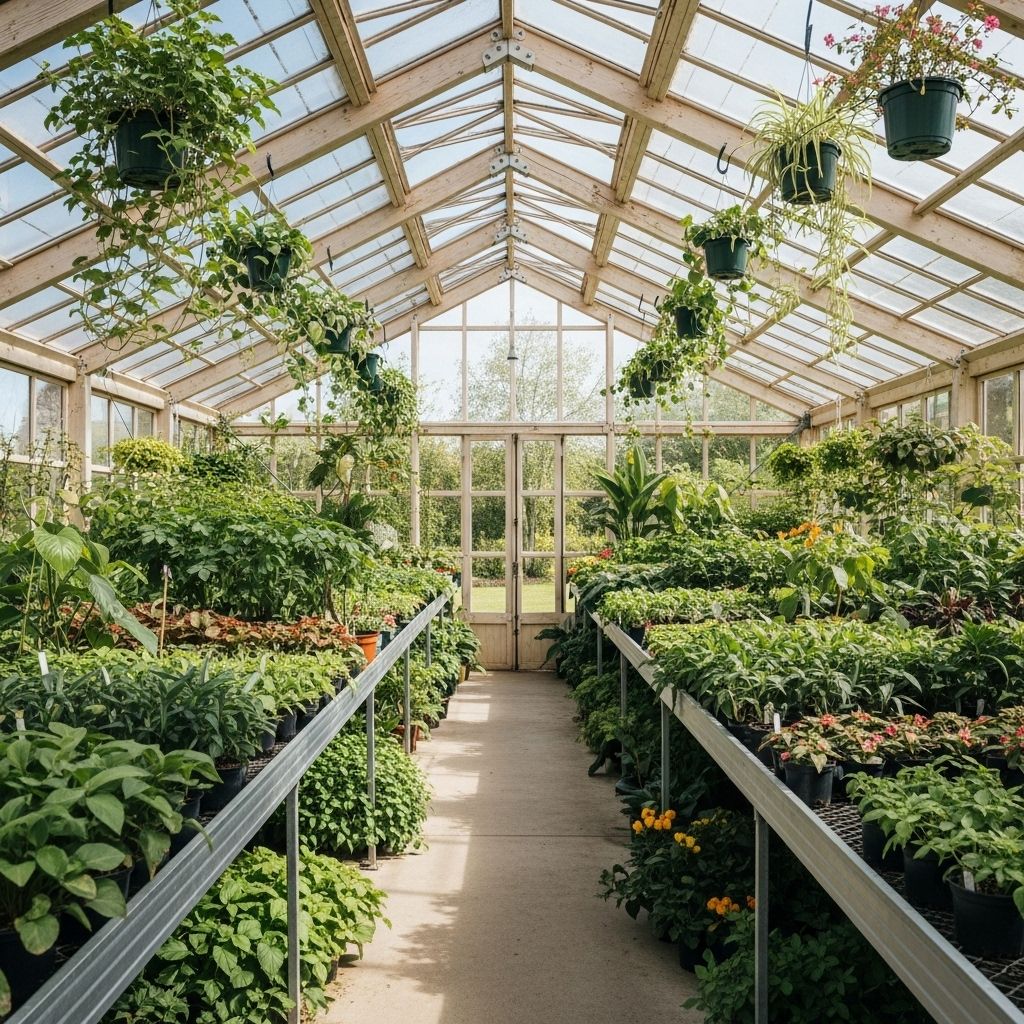Greenhouse Organization: 11 Strategies for Maximum Productivity
Transform your growing area into a neat workspace that nurtures thriving plants.

11 Proven Strategies to Organize Your Greenhouse for Maximum Productivity
Does your greenhouse feel cluttered, chaotic, or difficult to navigate? Whether you’re starting from scratch or seeking ways to improve your existing greenhouse setup, proper organization can revolutionize your indoor growing environment. Creating an efficient workspace not only streamlines your gardening activities but also promotes plant health, simplifies workflow, and inspires daily engagement. Explore these expert-backed tips for greenhouse organization!
Contents
- Why Greenhouse Organization Matters
- Recommended Workflow Zones
- Choosing the Best Greenhouse Shelving
- Tool and Supply Storage Solutions
- Soil and Amendment Organization
- Managing Pots, Seed Trays, and Containers
- Efficient Irrigation Management
- Sanitation, Plant Care, and Disease Prevention
- Lighting and Climate Control
- Optimizing Workflow and Space
- Routine Cleaning and Maintenance Tips
- Frequently Asked Questions
Why Greenhouse Organization Matters
Behind those glass or polycarbonate walls, your greenhouse is much more than a space for plants—it’s a hub for growth, propagation, experimentation, and harvest. Without careful planning, clutter can quickly dominate: seed packets misplaced, tools buried under soil bags, and vital supplies lost in the shuffle. A well-organized greenhouse is foundational for:
- Successful plant propagation and healthy starts
- Efficient workflow during sowing, potting, and transplanting
- Easy access to tools, soil, fertilizers, and seed trays
- Prevention of disease via proper cleaning and sterilization zones
- Streamlined record-keeping with planting calendars and logs
Whether your greenhouse is compact or sprawling, these organization tips adapt to any scale, maximizing both space and productivity.
Recommended Workflow Zones
Every productive greenhouse—even the smallest cabinet or cold frame—benefits from defined zones. Creating distinct locations for each activity prevents overlap and confusion, making each gardening task faster and simpler.
| Zone | Primary Purpose | Key Features |
|---|---|---|
| Irrigation Zone | Watering | Roll-up hoses, bins for nozzles and watering cans |
| Sanitation Zone | Tool & Container Cleaning | Sinks, spray bottles with bleach solution, work surfaces |
| Organization Zone | Planning & Tracking | Wall-mounted calendars, logbooks, seed storage |
| Propagation Zone | Sowing & Transplanting | Pots, soil, tools, ample workspace |
| Harvest/Processing Zone | Storing & Processing Crops | Drying racks, bins, packaging space |
If your greenhouse is extra small, you may need to combine zones or move bulk supplies to a nearby shed.
Zones ensure supplies and tools never get lost, tasks remain cleaner, and plants enjoy their ideal environments.
Choosing the Best Greenhouse Shelving
Labeled shelves are one of the easiest ways to streamline your space and give every item a designated home. Explore the top shelving options for durability, airflow, and customization:
- Wire Shelving: Promotes air circulation, rust-resistant, supports heavy loads.
- Plastic Shelving: Lightweight, moisture-proof, affordable.
- Wooden Shelves: Attractive, sturdy, best for dry zones (requires periodic treatment).
- Adjustable Shelves: Allow configuration for seasonal needs—raise or lower shelves to accommodate taller plants or large containers.
Always label each shelf and bin. Use waterproof, fade-proof tags for seeds, pots, soil bags, and fertilizers. This helps you instantly locate what you need and prevents accidental cross-contamination.
Tool and Supply Storage Solutions
Greenhouse gardening requires more than plant care—tools, hoses, and supplies are also essential. Organize them for efficiency and longevity:
- Install wall hooks for pruning shears, trowels, and hand tools.
- Keep rolling carts or caddies for easy mobility between zones.
- Designate a storage bin for each tool type (label each bin clearly).
- Store frequently used items at arm’s reach, while seasonal or specialty tools go higher up or into tucked-away bins.
- Consider a lockable cabinet for power tools (leaf blowers, chainsaws, hedge trimmers) to protect them from moisture and unauthorized use.
Gardening gloves, specialty pruners, and fertilizer scoops can be organized by activity, ensuring quick access for each job.
Soil and Amendment Organization
Keeping your main soil and soil amendments organized prevents mess, contamination, and guesswork:
- Use heavy-duty bins for storing potting soil and compost. Seal tightly to deter pests.
- Place perlite, vermiculite, fertilizers, and other amendments in smaller, labeled containers.
- Keep a soil scoop and dedicated measuring cups for each amendment.
- Stack bins under potting benches for easy access while working.
- Regularly rotate stock, using older products first to maintain freshness.
Managing Pots, Seed Trays, and Containers
Lost and mismatched pots or trays add clutter and result in wasted time hunting for the right sizes. A systematic approach:
- Sort containers by size and type (seed trays, transplant pots, grow bags).
- Stack trays and pots with separators to prevent breakage or jamming.
- Use shelves or racks labeled with pot sizes, ensuring you always have the right container for every sowing cycle.
- Keep recycled and sanitized pots in a dedicated area near the sanitation zone for easy use.
- Regularly purge cracked or unusable containers.
A well-ordered container station means seedlings get started promptly—and transplanting workflows remain smooth.
Efficient Irrigation Management
Watering is a daily greenhouse chore, but hose chaos and puddled floors can be neatly avoided:
- Install roll-up hose organizers near the irrigation zone.
- Use sectioned bins for hose nozzles and watering cans to prevent leaks and clutter.
- Store extra hoses coiled and elevated, away from plant beds.
- Install drip irrigation controllers, timers, or soaker hose systems for automated watering—preventing both underwatering and overwatering.
Efficient irrigation storage improves access, prevents tangles, and supports more precise watering habits.
Sanitation, Plant Care, and Disease Prevention
Disease prevention is a top priority in any propagation environment. Dedicate time and space for sanitation:
- Establish a cleaning station with a sink or spray bottles filled with diluted bleach solution for sanitizing pots, seed trays, and tools.
- Include drying racks for air-drying containers and equipment.
- Separate clean supplies from used, unsanitized items.
- Provide gloves and hand sanitizer to reduce cross-contamination.
- Empty all waste bins regularly and keep compost or trash segregated from growing zones.
Sanitation zones can reside inside or just outside the greenhouse entrance, depending on available space.
Keep surfaces and walkways free of debris to discourage insects and disease. Fans and vents aid humidity control, protecting seedlings and cured harvests from mold and fungus.
Lighting and Climate Control
Light and climate management are essential for a thriving greenhouse. Organize these systems to suit each crop and activity:
- Orient seedling trays southward to maximize spring sunlight.
- Set up grow lights, heat mats, or small space heaters for temperature and photoperiod control.
- Install thermostats and hygrometers close to plant zones for monitoring.
- Store climate-control accessories (fans, vent covers, insulation panels) in a dedicated bin labeled by season.
Smart climate control not only boosts germination rates, but also extends growing seasons and supports more diverse crops inside your greenhouse.
Optimizing Workflow and Space
Every square foot matters in a greenhouse. Design pathways and work surfaces for maximum mobility and comfort:
- Leave ample space between shelves, benches, and plant rows for easy movement.
- Use tarps or ground covers beneath work surfaces to catch spills and debris—simply shake out or wash after heavy tasks.
- Organize supply stations sequentially, so each gardening task flows logically (seed to soil to watering to transplant).
- Utilize vertical storage: wall shelves, hanging baskets, pegboards for small tools.
- Avoid deep stacks or buried bins—opt for shallow shelves and transparent containers for visual inventory at a glance.
A well-designed workflow means you’re never tripping over hoses or searching behind stacks of pots. It also makes greenhouse chores quicker and more enjoyable.
Routine Cleaning and Maintenance Tips
Maintenance isn’t complicated but does require consistency. Regular cleaning and inspection keep your greenhouse healthy and productive:
- Wipe down greenhouse panels and surfaces regularly with water to remove dust and dirt.
- Vacuum or sweep floors weekly—especially if you use brick, stone, or gravel, which collects debris and is tricky to clean.
- Drag out tarps or ground covers after messy work and shake clean outside.
- Summer deep clean: Take out all supplies, organize seed starting materials, disinfect surfaces, and restock bins.
- Monitor for pest hotspots, dead plant matter, or mold.
- Check irrigation systems for leaks or blockages; clear hose nozzles and containers.
Good maintenance habits add years to your supplies, keep pests at bay, and support optimal plant growth.
Frequently Asked Questions (FAQs)
Q: How can I organize a very small greenhouse?
A: Combine zones where possible—place tools, soil, and containers in stackable bins or shelves. Use vertical storage and consider a nearby shed or cabinet for extra supplies.
Q: What’s the best way to clean greenhouse floors?
A: Sweep or vacuum regularly. If you use gravel, tarps can help collect debris for easy removal. Brick or stone floors also benefit from vacuuming and periodic washing.
Q: How do I prevent plant diseases in the greenhouse?
A: Always sanitize containers and tools before reuse, segregate clean and dirty zones, and keep humidity controlled with fans and vents. Disinfect work surfaces and clean up debris daily.
Q: How should I store power tools in the greenhouse?
A: Store power tools, such as leaf blowers and hedge trimmers, in lockable cabinets or sturdy bins protected from moisture and weather.
Q: Can I start seeds without supplemental heat?
A: Yes, in spring, use south-facing windows for thermal mass. For larger spaces or cool climates, heat mats or space heaters offer dependable warmth for germination.
Final Thoughts
Every great harvest begins with a well-organized growing space. By zoning your greenhouse, labeling supplies, storing tools smartly, and cleaning regularly, you’ll transform gardening chores into an enjoyable part of your day. These proven organization strategies ensure you make the most of every inch, every season, and every plant in your greenhouse. Happy growing!
References
Read full bio of Shinta












